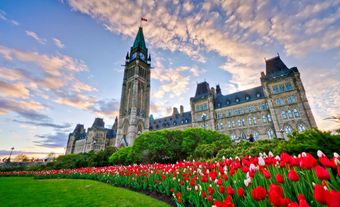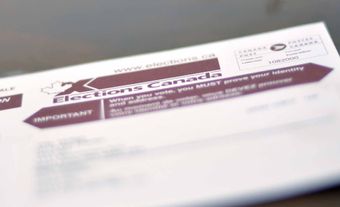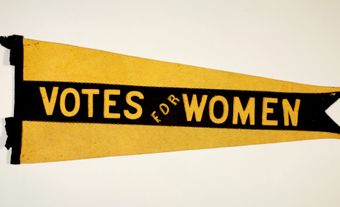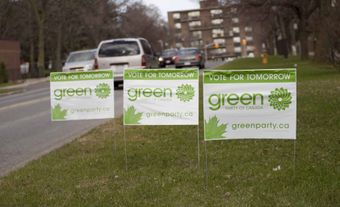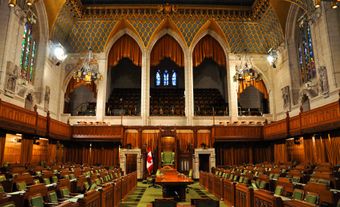The financial activities of political parties in Canada were largely unregulated until the Election Expenses Act was passed in 1974. Canada now has an extensive regime regulating federal political party financing; both during and outside of election periods. Such regulation encourages greater transparency of political party activities. It also ensures a fair electoral arena that limits the advantages of those with more money. Political parties and candidates are funded both privately and publicly. Election finance laws govern how parties and candidates are funded; as well as the ways in which they can spend money. (See also Canadian Electoral System.)
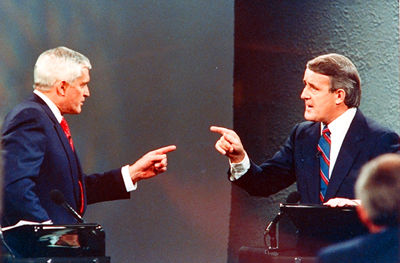
Party and Election Finance Laws
Private Funding
Canada’s federal election finance laws put limits on contributions to political parties and candidates. Only individuals — not corporations or trade unions — may donate. Contributions are limited to up to $1,500 a year to each political party and up to $1,500 to all of the registered electoral district associations; as well as contestants seeking the party’s nomination and candidates for each party. In addition, donors may give up to $1,500 to leadership contestants and up to $1,500 to independent candidates. These limits were set in 2015. The amounts increase by $25 each year. Politicians must disclose the names of anyone who donates more than $200.
Public Funding
Canada’s system of party and election finance regulation provides two forms of state funding to political parties and to candidates.
First, political parties and candidates are reimbursed for some of their election expenses. ( See Political Campaigning in Canada.) Political parties that received either two per cent of the national vote or five per cent of the vote in the districts in which they ran candidates get back 50 per cent of the money they spent. Candidates who received at least 10 per cent of the vote receive 15 per cent of the election expenses limit in their district. If the candidate spent at least 30 per cent of the limit during the election, the reimbursement increases to 60 per cent of what the candidate spent.
Second, Canada provides generous tax credits for donations to political parties and candidates. The first $400 of donations receives a 75 per cent tax credit. An amount between $400 and $750 receives a 50 per cent credit. Amounts over $750 receive a 33 per cent credit. An individual’s total tax credit in one year cannot exceed $650.
Spending
Political parties and candidates face limits on the amounts they may spend during an election. Political parties may spend 73.5 cents for every voter in districts where they are running candidates. For their local campaigns, candidates may spend an amount based on the population of the district in which they are running. This is typically between $75,000 and $115,000. If the election campaign is longer than 36 days, as was the case in 2015, the limits for both parties and candidates are increased proportionately.
Groups or individuals other than political parties and candidates — also known as third parties — may spend no more than $150,000 during an election. No more than $3,000 of that may be spent in any one district. Critically, all these limits to spending apply only during the election period; between when the writs of election have been issued (when the election is officially called) and election day.
Provincial and Territorial Regulation
Canadian provinces and territories have introduced their own political finance regulations. These vary by province and territory. All provinces and territories provide tax credits for contributions. They also require disclosure of the identity of donors who give more than a certain amount. Most provinces and territories set limits on the amounts that individuals can donate in any given year. All provinces and territories, except Alberta and Yukon, also put limits on spending during elections. Quebec, Nova Scotia, Manitoba and Alberta have banned corporate and other organizational contributions altogether. In these provinces, only individuals are allowed to give money to political parties.
Historical Background
Canada now has an extensive regime regulating political party and election finance. But this was not always the case. Before 1974, the financial activities of political parties were largely unregulated. From Confederation until about 1897, party funds were used to overcome weak partisanship. At the time, some partisan Members of Parliament did not always follow party lines. As a result, party leaders were directly involved in fundraising and in distributing election funds to ensure the loyalty of their followers. The Liberals and Conservatives also tended to rely on corporate donations. This led to periodic scandals, such as the Pacific Scandal. However, these were not enough to prompt comprehensive regulation of political party finance.
As partisanship crystallized, party leaders tried to distance themselves from the raising of campaign funds. Fundraising specialists gradually assumed this role. Party leaders were freed from direct involvement in this aspect of party politics. (See also Political Corruption; Conflict of Interest.)

Regulation: Election Expenses Act (1974)
Canada’s political parties began to run into financial difficulties in the 1960s and early 1970s. At the time, a series of minority governments resulted in more frequent elections. Meanwhile, television advertising and polling became integral parts of campaigns. As a result, political parties faced rising campaign costs. These factors led to the passage of the Election Expenses Act in January 1974. At the heart of the law was a bargain: political parties would receive state money in return for greater regulation of their financial activities.
The Election Expenses Act established most of the principles at the heart of Canada’s regulatory regime. It established a tax credit system for donations and a system of reimbursements for election expenses; as well as the principle of disclosure of election donations over $100. The legislation also placed limits on the amount that candidates and political parties could spend on campaigns.
This helped to ease the financial woes of Canada’s political parties. But the Election Expenses Act also changed the financial basis of Canadian parties. The tax credit system created an incentive for individuals to donate to parties. More importantly, it also created an incentive for political parties to solicit individual donations. As such, the new system reduced the reliance of parties on corporate donations.
Third-Party Spending
In the three decades following the passage of the Election Expenses Act, Parliament made only minor changes to the regulation of political parties and candidates. Most of the significant debate had to do with the regulation of third-party spending; that is, money spent during elections by groups other than political parties and candidates. In 1983, Parliament banned third-party advertising during elections. However, the National Citizens Coalition successfully challenged the law as a violation of the Charter of Rights and Freedoms in 1984. In 2000, Parliament passed the current limits on spending by third parties. The Supreme Court upheld these limits in 2004.
Political Party Allowances
The most significant change to Canada’s election finance regime came in 2004. Starting that year, corporations and trade unions could no longer donate to political parties. Instead, they could donate only small amounts to candidates. The law also placed a $5,000 limit on the amount that individuals could donate. In return for eliminating a significant source of party funding, Parliament enriched the tax credits and the reimbursements. Most significantly, the legislation established a quarterly allowance; it paid qualifying political parties $1.75 per vote per year for every vote they received in the previous election. The 2004 changes also extended the reach of finance regulation to things that had previously been seen as internal party matters. These include nomination and leadership contests.
These changes had a significant effect on the competitive balance between political parties. The Conservative Party flourished because of its success in raising money from individual donors. The Bloc Québécois did well because of the quarterly allowance. The legislation also contributed to the rise of the Green Party of Canada. The New Democratic Party (NDP) was reasonably successful under the new rules. The Liberals fared the worst; partly because of the party’s reliance on corporate donations. This was an ironic outcome for the creators of the law.
2008 Coalition Crisis
When the Conservatives came to power in 2006, they made minor changes to the 2004 regime. Corporate and union donations to candidates were eliminated. The maximum individual donation was lowered to $1,000. After the 2008 election, the Conservatives introduced legislation to remove the quarterly allowance. This sparked the 2008 coalition crisis. The opposition parties united to try to replace the minority Conservative government with a Liberal– NDP coalition backed by the Bloc Québécois. The government relented. However, after winning a majority government in 2011, it passed legislation phasing out the quarterly allowance. It officially ended in spring 2015.
The passage of the Fair Elections Act in 2014 saw minor changes to Canada’s party finance laws. These included an increase in the amount that individuals could donate to political parties and candidates (a $1,500 limit set in 2015 and increased by $25 each year); as well as increases to the spending limits.
Controversy
Because money is such an important resource in elections, party finance laws are often controversial. One of the enduring issues is the appropriate balance between public and private funding of parties; as well as the appropriate way to provide public funding. Proponents of public funding argue that it promotes transparency and reduces the potential for corruption. Opponents claim that public funding might insulate political parties from party members and voters who signal their discontent by withholding donations. The quarterly allowance was particularly controversial in this respect. For example, the Bloc Québécois got around 90 per cent of its income from public sources while the quarterly allowance was in effect.
The tax credit system, on the other hand, provides public funding to parties. But it also encourages them to connect with individual donors. It is much less transparent, however, than the other forms of public funding.
Another continuing source of controversy is the limits placed on third parties. Canada’s election finance regime recognizes political parties and candidates as the primary political actors in elections. It also places more stringent limits on the activities of advocacy groups and others who seek to intervene during elections. This limits the range of viewpoints expressed during elections. It also prevents parties from working around spending limits by having advocacy groups advertise on their behalf. (This scenario is common in the United States.)
A more recent concern has to do with the interaction of fixed election dates with spending limits. Election spending limits only come into effect when the election is called and only cover the official campaign. It typically lasts 36 days. With fixed election dates, however, parties, candidates and third parties all know when the election will be; they can therefore advertise significantly before the election is called. This renders the spending limits much less effective.
Significance
At the heart of the above controversies, and the regulation of political party financing itself, is a tension between the liberal democratic principles of freedom and equality. On the one hand, liberal democracies recognize the freedom of citizens to use their resources — including money — to achieve their political objectives. On the other hand, such freedom can compromise the fundamental political equality of citizens by giving those with access to greater financial opportunities greater influence over the electoral process. It is this tricky balance that Canada’s regulation of political party finance attempts to strike.
See also Canadian Electoral System; Chief Electoral Officer; Political Participation; Political Campaigning In Canada.

 Share on Facebook
Share on Facebook Share on X
Share on X Share by Email
Share by Email Share on Google Classroom
Share on Google Classroom

